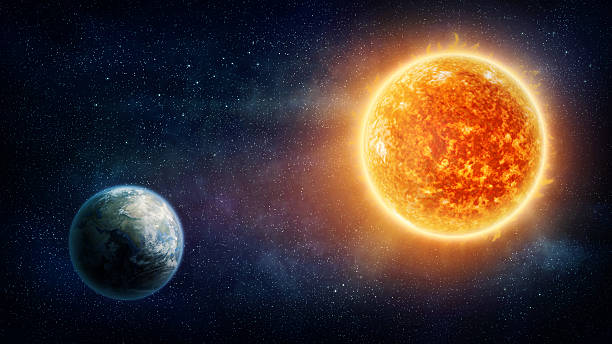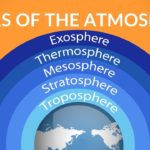How does heating and cooling affect the landscape around us? As the seasons change, what changes do you see outside? If you live in a temperate zone, the cooler weather probably brings changing leaf colors and hibernating animals. Later as the warm weather once again returns, so does life. New leaves, flowers, and baby animals welcome spring.
Other areas experience dry and wet seasons. The wet seasons bring life to the vast grasslands. Pools fill with water, frogs and fish come to life. Animals from hundreds of miles around migrate following the rain. Later as the rain slows down and the pools dry up, animals and plant life disappear.
Temperature has a dramatic and complex affect on the environments around us. In this article we will explore how these interactions take place.
Solar Heating
The most influential factor affecting weather in the atmosphere is heat. But where does this heat come from? A small amount of heat is generated from the Earth itself. This heat comes from a wide variety of sources, including hot springs, volcanic eruptions, radiation, and occasional forest fires. However, none of these sources produce heat on a large scale. Even a volcanic eruption is only hot enough to warm a very small area for a very short period of time.
The vast majority of heat found in our atmosphere comes from the Sun. Through the process of nuclear fusion, the Sun produces a massive amount of energy every moment of every day. In one second, the Sun produces more energy than mankind has ever used in our entire history.
Fortunately, most of that energy is radiated outward into the furthest reaches of the Solar System. If it was all focused on the Earth, what do you think would happen? Have you ever used a magnifying glass to focus sunlight onto a piece of wood? What happened? If you waited long enough, the wood probably began to smoke, leaving a black mark behind. Because only a very small portion of the Sun’s energy is intercepted by the Earth, we do not get over heated.
The Electromagnetic Spectrum
The heat produced by the Sun travels from the Sun to the Earth via waves known as electromagnetic waves. These waves can vary greatly in their wavelength. Have you ever thrown a rock into a lake? What happens when you throw a small pebble into the water? The resulting ripples are small, and each wave is close to the next wave; they have a short wavelength. Now, consider what would happen if you threw a large boulder into the water. Instead of small ripples, you get large waves. These larger waves are spaced further apart from one another. Thus, they have a large wavelength.
Because the electromagnetic waves traveling to the Earth from the Sun come in a variety of lengths, scientists consider them to be a spectrum. Thus, we refer collectively to all these waves as the electromagnetic spectrum. The electromagnetic spectrum is a big word that simply refers to all the different sized waves of energy traveling outward from the Sun, as well as from many other objects in the Universe.
To better understand the electromagnetic spectrum, scientists break it into three separate categories or divisions. The shortest waves are called ultraviolet waves. The medium sized waves are called visible light waves, and the longest waves are called infrared waves. Even longer waves also are categorized into radio waves, microwaves, and so forth.
Ultraviolet Waves
Waves measuring under 0.4 micrometers are referred to as ultraviolet. These short waves are extremely dangerous to living organisms. Long term exposure to ultraviolet radiation would seriously hurt and even kill most lifeforms on Earth, including humans.
The Sun produces a significant amount of ultraviolet waves. Fortunately, most of these waves never reach the surface of the Earth. They are either absorbed, or reflected and bounced away by molecules in the upper atmosphere.
Visible Light Waves
Waves with a length of between 0.4 and 0.7 micrometers can be detected by the human eye. For this reason we call these waves visible light. As you look around the room, everything you see has these waves bouncing off of them. If they didn’t, you would not be able to see them. What your eyes pick up and turn into a picture in your brain are these visible light waves.
Shorter visible light wavelengths are bluer in color, while longer visible light wavelengths are redder in color. The wavelengths detectible by the human eye represent only about 3% of the total electromagnetic spectrum.
Infrared Waves
Infrared waves are commonly referred to has heat rays. Heat is in fact infrared radiation. Hold your hand next to a hot stove. Do you feel the heat radiating off of the stove and traveling towards your hand? If our eyes could see infrared radiation, what would it look like? You would see anything that produces heat, including plants and animals, no matter how dark it was. On average, the Sun produces very little infrared radiation compared to the amount of ultraviolet radiation and visible light that it creates.
Shortwave and Longwave Radiation
Visible light and ultraviolet radiation are commonly called shortwave radiation, while infrared radiation is referred to as longwave radiation. The Sun radiates energy mainly in the form of visible light, with small amounts of ultraviolet and infrared radiation. For this reason, solar radiation is usually considered shortwave radiation.
The Earth produces virtually no visible light, or ultraviolet radiation. Almost all of the natural radiation created by the Earth is infrared, or heat. Thus, we refer to the terrestrial radiation as longwave radiation.






